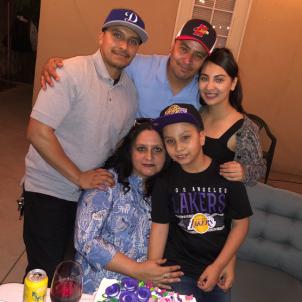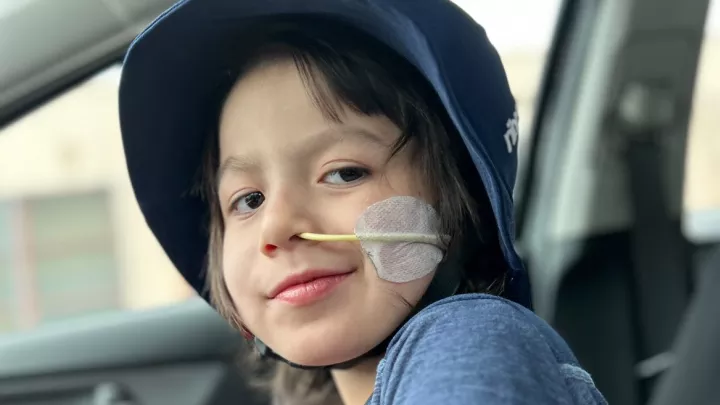
A Surgical Solution Eliminates Seizures in Epilepsy Patient
Peering down from the pitching mound, Andrew eyed the first batter of the game, a kid named Munoz. He knew him by his last name, the way boys know each other on the baseball diamond at age 12.
Watching from the stands with the same focus was Laura, Andrew’s mother. Between them, they had one thought: Don’t let the leadoff guy get on base.
As Andrew prepared to throw only his fourth pitch of the afternoon, he stared ahead for an unusual amount of time—until it appeared to Laura that he wasn’t staring at all. He looked to be frozen, immobilized.
“I didn't know what was happening,” she says, “but I knew something was wrong because he wasn't pitching the ball.
Andrew’s coach, a registered nurse, knew the traits of a seizure when he saw them and he raced out to the mound. As he got there, Andrew began convulsing. His coach caught him just as he was about to collapse to the ground.
An ambulance drove Andrew to the local emergency room, where he experienced a second seizure, which then got him transported to Children’s Hospital Los Angeles. At CHLA, a CT scan and an MRI found the source of the seizures—a lesion called a meningioangiomatosis, described as a buildup of benign plaque that warped the electrical activity in the frontal and temporal lobes of Andrew’s brain.
It’s an exceedingly rare mass—a literature review found only 101 reports of it. What set it off? Did it just grow, or had it been lying dormant for 12 years?
“We don't know for sure because he didn't have a reason to get an MRI before this,” says CHLA neurologist and epilepsy specialist Madeline Kahan, MD. She says meningioangiomatosis is so uncommon, Andrew’s case was her first encounter with it.
“Most likely, it’s something he was born with. We don't always have an explanation for why people with brain lesions start having seizures when they do. We think potentially it's due to some hormonal changes around the preteen years, but it can be variable. People with lesions like Andrew's can present with seizures at any time.”

Surgery becomes an option
Andrew spent nearly a year being treated with epilepsy medications by a local doctor, but with only partial success. The medication eliminated the larger, dangerous tonic-clonic seizures, which cause the convulsing and stiffened limbs that Andrew suffered on the baseball field, but did not subdue the smaller seizures, known formally as focal impaired awareness seizures, in which he would fall into a blank stare for 10-15 seconds, before popping back to consciousness.
Once a second drug didn’t help, removing the lesion surgically became an option. Andrew was transferred to CHLA’s Comprehensive Epilepsy Center, the only freestanding pediatric epilepsy center in Los Angeles designated as Level 4, which indicates a facility with the greatest expertise and the best outcomes—and, naturally, the highest volume of patients.
“Typically, when patients come to us, it's because they've failed multiple seizure medications and we're starting to think about other treatments,” Dr. Kahan says. She names a ketogenic diet and neuromodulation devices as alternatives, but explains that for Andrew’s diagnosis neither made sense. “For a patient with a known lesion in one part of the brain causing the seizures, surgery is the closest chance to a cure, so to speak, that we have with epilepsy.”
However, before moving forward, Dr. Kahan says the data must indicate that a patient is a good candidate for surgery—meaning that the procedure will work, and without presenting too great a risk.
“Everything has to show that the seizures are coming from a place that's safe to remove, and that the surgery will have a high likelihood of treating the seizures and getting the patient off medications in the future.”
Far from ‘important brain’
To determine that, doctors put Andrew through a week-long EEG to view the electrical activity in his brain. They lowered his medication, deliberately inducing seizures so they could capture them and then compare their location as shown on the EEG with what the MRI indicated.
Another scan, called a functional MRI, showed that Andrew’s language ability was managed by the left side of his brain, safely away from the epicenter of the surgery in the right hemisphere, where the lesion sat.
Still, the operation would demand some precision, says CHLA neurosurgeon Virendra Desai, MD. Though the lesion was largely far from “important brain,” he says, “it was close to a small area of the brain that controls movements, and our cognitive processing. We needed to be really specific with how much tissue we would take.”
Included in the evaluation was genetic testing, to check for a hereditary condition called neurofibromatosis type 2 (NF2), which can be linked to Andrew’s type of lesion. He tested negative.
Advising the family that surgery was a favorable option required unanimity from the extended care team.
“It was me, my four other epilepsy colleagues, and the surgical team,” Dr. Kahan says. “Before any of our patients go to surgery, all of us have to be in agreement, and we all felt like he was an excellent candidate. Everything we were testing for came back pointing toward surgery."
Weighing the odds

According to Dr. Kahan, removing the lesion surgically offered Andrew a 60%-80% chance of being rid of seizures and eventually weaned off medication. But a lesser outcome would still represent an improvement.
“Even if he wasn’t able to get off medication, our hope was that he could have reduced seizures and have less medication, and fewer side effects, so he could live a more normal life,” Dr. Kahan says. “It's not all or nothing. We have several patients whose seizure burden is reduced, but they're not able to come off medications.”
The worst possible result would be a standstill—no reduction in Andrew’s seizures or his medication. The decision couldn’t be called a win-win, but it seemed like a win-win-break even.
But even with the most encouraging odds, agreeing to turn your child over for brain surgery is not easy. “As a parent, you don't want to make that decision,” Laura says.
One voice in the family that pushed for the surgery was Laura’s adult daughter, a respiratory therapist at CHLA. “My daughter was a big advocate for it because she sees all the miracles that happen there.”
A larger voice was Andrew’s. “He was saying, ‘If there's a chance I won’t have seizures and I can play ball with no problem, then yes.’ We were a mess. The only thing that kept us going was the fact that he was so strong. He was like, ‘People fly from all over to Children's Hospital to get things done. We're here. Mom, it's going to be fine. I'm going to go in, they're going to get it done, and I'll see you on the other side. Don't worry.’”
That Mamba mentality
The surgery was performed June 17, 2024, 10 days after Andrew graduated from middle school. For five months since, now almost 15 years old, he has been seizure-free.
That’s not enough time to declare the seizures defeated, but it’s trending that way. If the EEG and MRI scheduled for December show no abnormal brain activity, Dr. Kahan says they can consider starting to remove Andrew’s medication.
“Once we get to five and then 10 years of no seizures, the data becomes even better for lasting seizure freedom.”
Andrew is regaining the parts of his life that were disrupted by the seizures. He’s been playing baseball all along, closely watched by his mom and with doctors’ consent.
“As long as they are well-supervised, we try to let our kids with epilepsy live as normal a life as possible,” Dr. Kahan says.
Laura says the alternative would have created more harm. “If we had told him, ‘You can't play anymore because we're too afraid,’ the damage would have been much greater, I think.”
He received a letter from his CHLA doctors clearing him to play school sports without restrictions. He’s playing in a recreational baseball league now and hopes to land a spot on his high school team next fall.
Clearance was all Andrew needed. He didn’t need any convincing, having never been fearful of his condition or concerned with others knowing about it.
“He actually wants people to know,” Laura says. “He's got friends who look out for him. Just in case something does happen, they can assist him.”
Andrew's message to his mother before his brain surgeryMom, it's going to be fine. I'm going to go in, they're going to get it done, and I'll see you on the other side. Don't worry.
What’s the source of this self-assurance? Though his passion is baseball, Andrew says it comes from a basketball legend, whom he was turned on to by his older brother.
“Mamba mentality,” he says, citing Kobe Bryant’s famous approach to taking on challenges. “I didn’t get to see him play much, but I’ve watched highlights. Tough, keep yourself in the game, focus, never give up. I take that from him.”
For now, Laura remains “on seizure watch,” she says. As she speaks, she’s at her customary station, seated at the edge of Andrew’s baseball practice.
“I watch him like a hawk. I’m a little more comfortable because he’s gone this long after surgery without anything, but I still have to be here.”
As the ping of ball on aluminum bat is heard in the background, she shouts, “Go! Go! Go! I can see him from here. He’s doing fine.”


